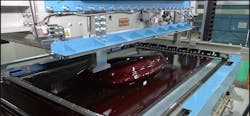Company targets EV makers with film system to replace paint
By Bruce Geiselman
Aero Sustainable Material Technology, based in Columbus, Ohio, is marketing what it calls an environmentally friendly process that could replace spray-applied paint lines in new electric vehicle (EV) plants. The system includes special film that covers vehicles, along with the technologies to apply it.
Aero CEO James E. McGuire Jr. said the film system could save automakers from having to invest in spray paint lines, reduce the weight of EVs and improve aerodynamics, while producing no emissions of carbon, volatile organic compounds or PVC compounds.
The Aero system was originally developed in 2008 as a lightweight film-based alternative to paint for the Boeing 787 Dreamliner program — the all-composite, ultra-lightweight commercial airliner platform.
Since then, the coating system has been adapted for optimization in the broader automotive industry.
McGuire also is a driver for United Autosports, piloting cars with Aero’s durable and lightweight finish for the U.K. auto racing team.
Automotive paint lines are among the most expensive systems in a manufacturing facility, often costing hundreds of millions of dollars to install and maintain as they consume the most energy in the plant and contribute to carbon dioxide emissions and air pollution. Aero’s film system, which has been commercially available for several years, is being marketed to EV manufacturers in part because they often are building new manufacturing facilities and have not yet invested in capital-intensive paint lines, according to the company.
Aero’s multi-layer urethane-based film system is “up to 17,000 percent more durable than traditional spray in longevity, environmental resistance, [and] scratch and chip protection,” according to the company. In addition, its “self-healing clear coat” resists micro abrasions, such as swirl marks often associated with washing a painted car. The film maintains a factory finish through a vehicle’s life by resisting fading, discoloring, hazing and changes in gloss, according to the company. The film also is 50 percent to 80 percent lighter than traditional spray paint, McGuire said.
Depending upon the color and the finish desired by the customer, the coating could have between three layers and 10 layers of film, including an acrylic pressure-sensitive adhesive layer that attaches to the vehicle’s body, urethane paint layers and a clear-coat urethane layer on top. The proprietary adhesive layer, while providing a permanent bond, can be “deactivated,” allowing it to be stripped for repairs or end-of-life recycling.
“At the end of the lifecycle of the component … you can remove it without the film falling apart,” McGuire said. “That is super-critical for recyclability. Imagine that I’ve got a TPO [thermoplastic polyolefin] fender that is damaged or whatever or at the end of the lifecycle of the car, I just peel off the urethane, and that goes to one recycle stream, and the TPO gets reground and used as a virgin TPO. That’s the future.”
Aero converts the film into fuel pellets for cement kilns, McGuire said.
The company, which produces the film at its plant, can match any color. The film is available in gloss or satin finishes and can incorporate pearls, metallics and multi-step colors.
Aero films can be applied to a variety of substrates, including composites and metal surfaces, either with an automated process. The Fuse Automotive Coloring System, developed with Japanese equipment manufacturer Fu-se Vacuum Forming Co. Ltd., applies film using the company’s Ultra-Wide TOM Machine. The machine operates like a traditional thermoforming machine, but without the need for heat, which avoids the generation of greenhouse gases associated with a thermoforming machine, McGuire said.
“It’s dual vacuum forming,” McGuire said. “We don’t need heat to do it. It’s very sophisticated, and we can achieve really excellent results with it.”
The film also can be applied by hand on smaller parts, using wet or dry application methods.
While Aero’s film currently is used on Land Rover Defender SUVs with a satin-matte finish, Aero soon will announce films will be available on other vehicles, McGuire said.
“A lot of these new sustainable technologies are really in the engineering phase and pre-commercialization,” McGuire said. “That’s not where we are. It’s commercial technology.”
In addition to being durable and better for the environment, applying Aero film also is faster than traditional automobile painting, McGuire said.
“The cycle times are much lower,” McGuire said. “Obviously, you don’t have to bake it and cure it and that sort of thing. To introduce a part into the dual vacuum former, like the hood of a car, is about a 10-minute process to put it in, and get it vacuum formed, and pull it out. It takes a lot longer to do a hood by the traditional spray method.”
Because application of the film doesn’t require installation of spray paint lines, parts suppliers could begin supplying automakers with decorated end parts rather than having the automaker paint the car at its own factory.
“It gives an opportunity to really change how vehicles are assembled,” McGuire said. “Right now, they paint in their paint line, the doors and the hoods, all the bolt-on bonnets. They paint everything in their factory. Now, you can push it further back to the Tier 1. The Tier 1 can apply the film and supply a pre-painted door, pre-painted fender, pre-painted hood. It adds significant revenue opportunity to the Tier 1 component supplier, and it makes it a lot simpler for the OEM.”
Bruce Geiselman
Aero Sustainable Material Technology, Columbus, Ohio, 614-354-9935, [email protected], https://aerotechnology.com/
About the Author
Bruce Geiselman
Senior Staff Reporter Bruce Geiselman covers extrusion, blow molding, additive manufacturing, automation and end markets including automotive and packaging. He also writes features, including In Other Words and Problem Solved, for Plastics Machinery & Manufacturing, Plastics Recycling and The Journal of Blow Molding. He has extensive experience in daily and magazine journalism.
